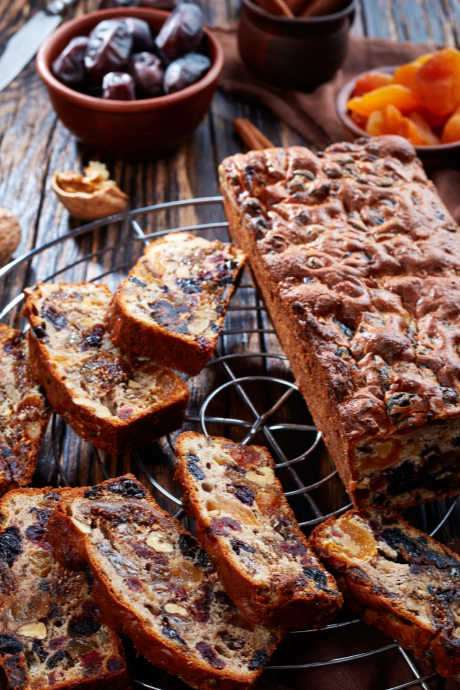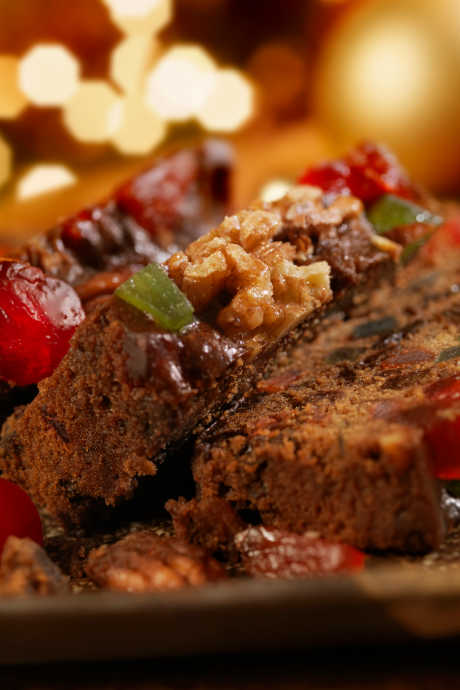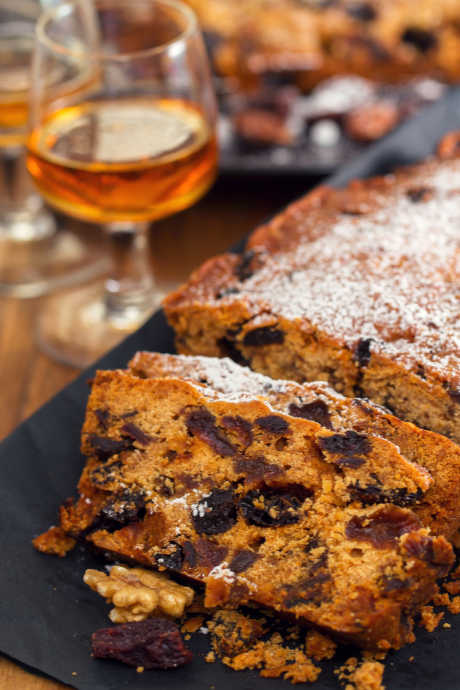Fruitcake: Yes, Please or We'll Pass
Posted by Julie on Dec 27th 2018
This special holiday edition of our “Yes, Please or We’ll Pass” series will cover a tradition that has nearly died out, thanks to bad press. We’re talking about fruitcake, that infamous holiday recipe that often resembles a doorstop instead of a dessert.
Is fruitcake really as awful as we’ve always heard? We decided to put it to the test and see whether we’d say yes, please or we’ll pass.
Fruitcake: What Is It?
Everybody makes fun of fruitcake, but how many people even know what’s in it? Fruitcake recipes abound, but Thrillist breaks it down to three primary components: bread, liquor, and a combination of fruit and nuts. Other details may vary, depending on the preferences of the baker.
Before we get into those details, we ought to explain how fruitcake became a trend in the first place. The CBC’s kids website condenses the 2000-year history of fruitcake into a single paragraph. Like other aspects of our culture, fruitcake came to the US via England, where it’s a traditional wedding cake. In fact, both Princess Diana and Kate Middleton served fruitcake at their weddings.
Fruitcake: According To the Experts
This detailed piece from What’s Cooking America covers all the ins and outs of making fruitcake. It’s a fantastic reference, especially if you want to be thoroughly authentic. Be warned that making authentic fruitcake will take lots of time, and we don’t just mean the baking time.
To give you an idea of how much time is required, the fruit and nuts should be soaked in liquor for two days or more before mixing them into the batter and baking the cakes. But after the cakes come out of the oven, the real waiting begins. Fruitcake should be aged; keep it in a cool, dry location for a month at minimum. What’s Cooking America even notes that you should brush the outside of your cakes with liquor every week, and then wrap them back up.

All the alcohol in fruitcake is there for good reason: It helps prevent spoilage. The same is true for the sugar in the fruit and the cake batter. Before modern food storage and preservation methods, alcohol was an excellent way to ensure food was safe to eat long after preparing it. While it may seem strange to soak your fruitcake in booze, know that this method has been used for centuries.
A modern fruitcake expert, Virginia Glass, was quoted in Thrillist regarding her thoughts on why fruitcake is so universally loathed. She blamed fruitcake’s bad reputation on the glacé cherries in those unnatural red and green colors. However, she also believes that fruitcake, when done right, can be utterly delicious. She predicted that fruitcake may become a fad once more, given the right location and audience.
Fruitcake: How We Made It
While we were perusing Mid-Century Menu when writing our vintage recipes post, we found this fruitcake recipe and bookmarked it. It’s from a 1953 issue of Better Homes & Gardens — we really want to know where Retro Ruth finds her recipes! — and it’s by Wesson Oil. We gathered the ingredients we already had in the pantry and cupboards, and then we headed out to stock up on fruit and nuts. We also bought Wesson Oil, for added authenticity.

The recipe was easy to follow. We were pleased to see how it even incorporated a couple of the tips from What’s Cooking America. First, mix a cup of flour with the fruit and nuts. This step helps ensure all those heavy items don’t sink to the bottom of your loaf of fruitcake. Second, put a pan filled with water on the bottom rack of your oven, with your loaf pan on the middle rack. You can use a baking pan or a jelly roll pan. The water helps ensure your fruitcake doesn’t dry out during the long baking time. But because your fruitcake will be in the oven for up to three hours, check the water level occasionally and refill as necessary.
Our fruitcake was done in two and a half hours, and we let it cool in the loaf pan. Once we turned it out of the pan, we wrapped it in plastic wrap and a layer of aluminum foil. Then we let it sit on the kitchen counter for two days. We didn’t baste it with alcohol — in fact, there’s no alcohol in this recipe — nor did we allow it to ripen for a full month. Instead, we brought it in to the office to share.
Fruitcake: Yes, Please!
What did everyone think? We were all pleasantly surprised by how moist this fruitcake turned out to be. While none of us really like glacé cherries, they didn’t keep anyone from finishing their slice. Our resident semi-professional baker offered her thoughts:
“I have to say this recipe wasn’t bad. I liked the nutty, warm spice flavor, and it has a decent texture. I was surprised when I realized I’d eaten my whole slice.”
On Mid-Century Menu, Ruth lamented that her fruitcake wasn’t spicy. We suspect the spiciness of our fruitcake was a result of grinding whole cloves and allspice, rather than using ground spices. There wasn’t simply a hint of spice in our fruitcake; it was a pronounced flavor. If you like a more subtle flavor, use ground cloves and allspice. Otherwise, get out the mortar and pestle or a Microplane spice grater and go to town.
Ruth also suggested this fruitcake could benefit from some brandy, and we have to agree it would be more authentic with alcohol. We aren’t sure if it would be too boozy to swap the entire cup of fruit juice with brandy, so be judicious with this substitution.

Finally, we took yet another suggestion from What’s Cooking America by tailoring the fruit in our cake according to our personal preferences. That meant no citron or figs. Instead, we added more candied cherries and pineapple and raisins. The idea is to keep the proportions of the original recipe, even if you use different fruit and nuts. Feel free to use other dried or candied fruits, or different types of nuts if you like them better.
While we may not have the patience to baste our fruitcake weekly with brandy or allow it to ripen for months before eating, this recipe was relatively quick and easy, and much more appetizing than we anticipated. Yes, please!

